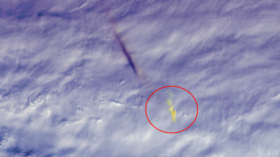NASA shares IMAGES of meteor as powerful as Hiroshima bomb that no one spotted

NASA published satellite photos of a mysterious and powerful meteor which appeared in the sky in December and released 10 times more energy than the Hiroshima atomic bomb, but somehow wasn’t seen by anybody at the time.
Did you miss the meteor ☄️ spotted over the Bering Sea in December 2018? Don’t worry — our satellite 🛰 saw it! The MODIS instrument on @NASA's Terra satellite caught this view 👀 of the meteor’s shadow, visible as the gray streak above the clouds ☁️.https://t.co/VUDxPjWgqnpic.twitter.com/s8pcO6XxUE
— NASA Earth (@NASAEarth) March 22, 2019
The MISR instrument, also on Terra 🛰, saw the large "fireball" — the term used for exceptionally bright meteors ☄️ that are visible over a wide area — as it exploded 💥 about 16 miles above the Bering Sea, far enough way to pose no threat. pic.twitter.com/lyjyZKBZOm
— NASA Earth (@NASAEarth) March 22, 2019
The elusive meteor released about 173 kilotons of energy as it smashed through the Earth’s atmosphere at about 115,200kph (71,600mph). It’s the most powerful meteor to hit Earth since 2013, when the Chelyabinsk meteor struck in Russia.
Images taken minutes after the December 2018 meteor hit show the shadow of the fireball’s trail in the sky, where it appeared over the Bering Sea off Russia’s Kamchatka Peninsula and turned the clouds orange.
Also on rt.com Earth hit by meteor explosion 10 times more powerful than nuclear bomb, but no one noticed (PHOTOS)NASA captured images on its Terra satellite, with five of the nine cameras on the Multi-angle Imaging SpectroRadiometer (MISR) capturing a series of photographs about seven minutes after the meteor hit the atmosphere. The space agency then used those snaps to create a GIF.
A still true color image was captured by the Moderate Resolution Imaging SpectroRadiometer (MODIS) instrument, and shows the remnants of the meteor's path as a dark shadow cast on the clouds.
Some colour views of the #meteor that flew over the North Pacific in December 2018, taken by Japan's #Himawari satellite.The meteor is really clear here - bright orange fireball against the blue + white background!Background: https://t.co/r403SQxicZpic.twitter.com/ctNN8zxsXb
— Simon Proud (@simon_sat) March 18, 2019
The US space agency wasn’t the first to photograph the powerful meteor, however, as a Japanese weather satellite published its image of the burning debris this week.
Like this story? Share it with a friend!














